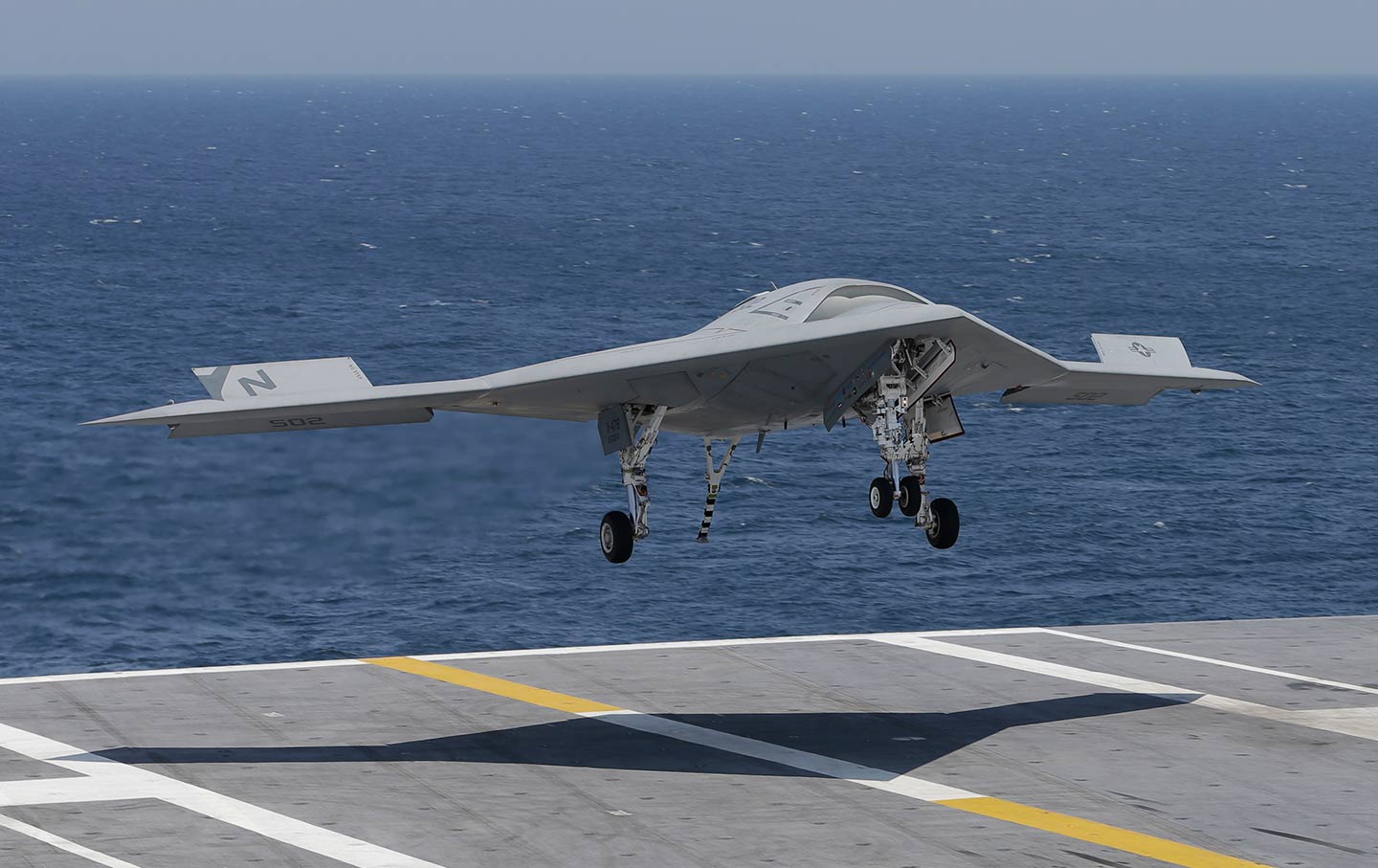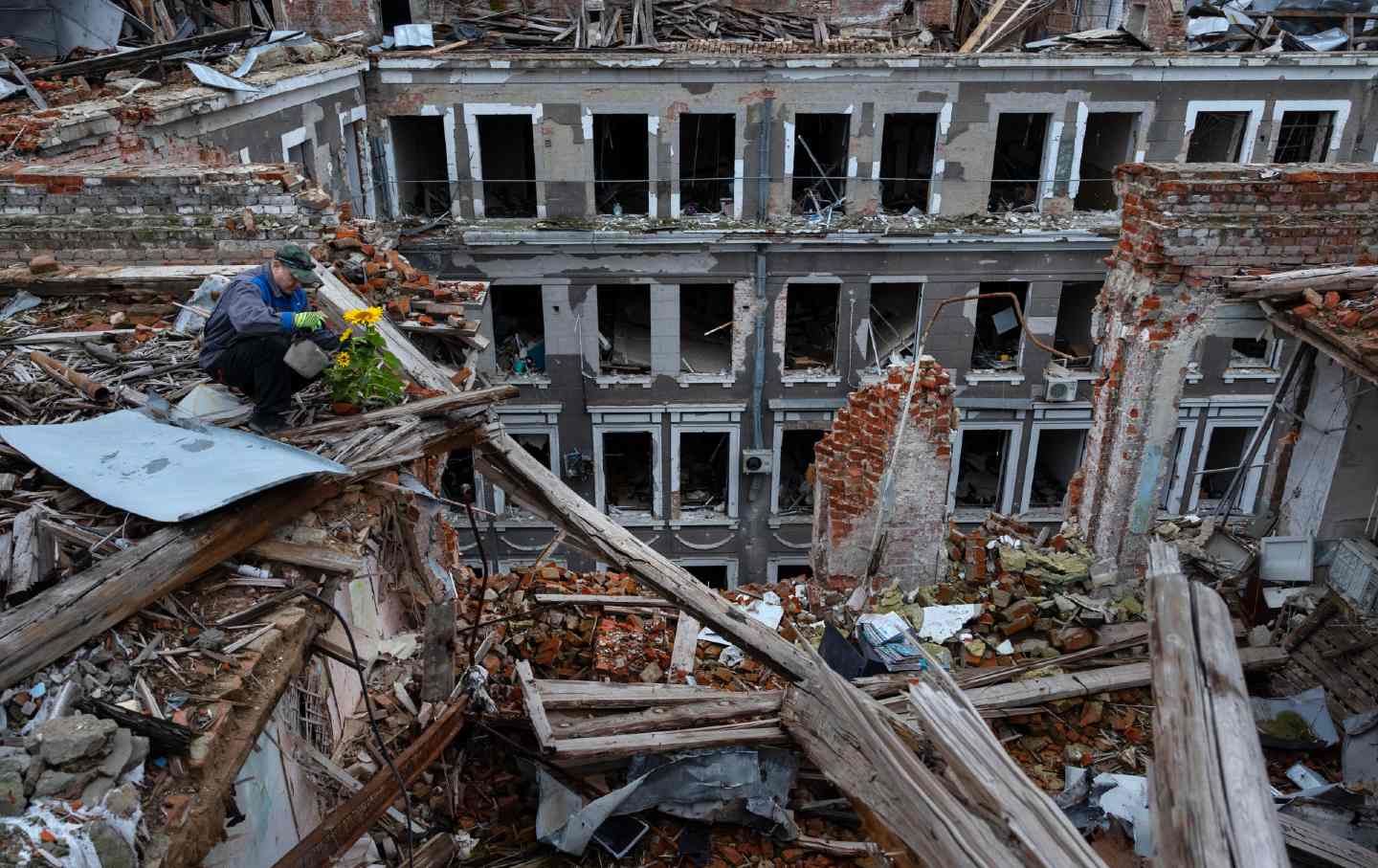The Race to Amass the Most Drones Will Only Bring Us Closer to Nuclear War
With swarms of such devices battling other swarms, the risk of catastrophic defeat will loom ever larger, making the temptation to employ nuclear weapons that much harder to resist.

A US Navy drone approaches the deck of nuclear the aircraft carrier USS George H.W. Bush off the coast of Virginia on July 10, 2013.
(Steve Helber / AP Photo)This article originally appeared at TomDispatch.com. To stay on top of important articles like these, sign up to receive the latest updates from TomDispatch.com.
A war with China may not be inevitable, Deputy Secretary of Defense Kathleen Hicks observed recently, but it’s a genuine possibility, and so this country must be prepared to fight and win. But victory in such a conflict will not, she suggested, come easily. China enjoys an advantage in certain measures of military power, including the number of ships, guns, and missiles it can deploy. While America’s equivalents may be more advanced and capable, they also cost far more to produce and so can only be procured in smaller numbers. To overcome such a dilemma in any future conflict, Hicks suggested, our costly crewed weapons systems must be accompanied by hordes of uncrewed autonomous ships, planes, and tanks.
To ensure that America will possess sufficient numbers of “all-domain attritable [that is, expendable] autonomous” weapons when a war with China breaks out, Hicks announced a major new Pentagon program dubbed the Replicator Initiative. “Replicator is meant to help us overcome [China’s] biggest advantage, which is mass. More ships. More missiles. More people,” she told the National Defense Industrial Association as August ended.
Because we can’t match our adversaries “ship-for-ship and shot-for-shot,” given the prohibitive costs of traditional weapons systems (which must include space for their human crews), we’ll overpower them instead with swarms of autonomous weapons—unmanned aerial vehicles (UAVs and UASs), unmanned ground vehicles (UGVs), unmanned surface vessels (USVs), and unmanned subsea vessels (UUVs, or drone submarines), all governed by artificial intelligence (AI) and capable of independent action.
“We’ll counter the [Chinese military’s] mass with mass of our own,” she declared, “but ours will be harder to plan for, harder to hit, harder to beat.”
Needless to say, Hicks’s announcement of the Replicator Initiative has raised many questions in the military-industrial-congressional complex and elsewhere about this country’s ability to produce such a vast array of technologically advanced weaponry in a short period of time. The US military does, of course, already possess an array of remotely piloted drones like the infamous Predator and Reaper aircraft used in this country’s Global War on Terror to hunt and kill enemy militants (and often nearby villagers as well). Those are not, however, capable of operating autonomously in swarms, as envisioned by Hicks. Even if Congress were to vote the needed hundreds of billions of dollars to develop such weapons—and, at the moment, there’s no certainty of that—and even if the Pentagon could overcome its own bureaucratic inertia in passing such funds on to defense contractors, will those companies be capable of developing the necessary advanced software and hardware anytime soon? Who knows?
After all, the Department of Defense has already awarded many millions of dollars to assorted AI start-ups and traditional contractors over the past half-dozen years to develop advanced UAVs, UGVs, USVs, and UUVs, and yet not a single one is in full-scale production. The Navy, for example, first began funding the development and construction of a prototype Extra-Large Unmanned Undersea Vessel (XLUUV) in 2019. But as of today, no finished submarine has yet been delivered, and none are expected to be combat-ready for years. Other major autonomous weapons projects like the Air Force’s “loyal wingman” drone, intended to accompany fighter planes on high-risk missions over enemy territory, seem to be on a similar track.
Still, questions about this country’s ability to deliver such systems on the tight timetable Hicks announced should be the least of our concerns. Far more worrisome is the likelihood that such a drive will ignite a major new global arms race with China and Russia, ensuring that future battlefields will be populated with untold thousands (tens of thousands?) of drone weapons, overwhelming human commanders and increasing the risk of nuclear war.
The Illusion of US Drone Dominance
In making the case for the Replicator Initiative, Hicks touted America’s advantage in technological creativity and know-how. “We out-match adversaries by out-thinking, out-strategizing, and out-maneuvering them,” she insisted. “We augment manufacturing and mobilization with our real comparative advantage, which is the innovation and spirit of our people.”
From her perspective, China, Russia, and this country’s other adversaries are more reliant on traditional forms of military mass (“more ships, more missiles, more people”) because they lack the natural birthright of all Americans, that “innovative spirit.” As she asserted, “We don’t use our people as cannon fodder like some competitors do,” we win by “out-thinking” them.
Putting aside the ethno-nationalism, even racism, in those remarks (bringing up centuries-old Western claims that Asians and Slavs are intellectually inferior and so more submissive to czars and emperors), such an outlook is still dangerously flawed and inaccurate. China and Russia have no lack of smart, creative scientists and engineers and, far from trailing the United States in the development of autonomous weaponry, have actually taken the lead in certain areas.
You need look no further than the Pentagon’s own publications to learn about China’s advances in autonomous weapons systems. In the 2022 edition of its annual report on “Military and Security Developments Involving the People’s Republic of China [PRC],” it affirmed that China is continuing with its “comprehensive UAS [unmanned aerial system, another term for UAVs] modernization efforts, highlighted by the routine appearance of ever more sophisticated UASs across theater and echelon levels.”
That report also indicated that China is making rapid advances in the development of AI software for use by autonomous weapons systems in complex combat operations of exactly the sort envisioned by Deputy Secretary Hicks: “In addition to maturing their current capabilities, China is also signaling its efforts in next generation capabilities.… In these concepts, PRC developers are demonstrating an interest in additional growth beyond [intelligence and electronic warfare missions] into both air-to-air and air-to-ground combat, with a substantial amount of development displaying efforts to produce swarming capability for operational applications.”
Popular
“swipe left below to view more authors”Swipe →The Department of Defense seldom reveals its sources for such assertions, making it difficult for outside analysts to assess their validity. As a result, it’s hard to know how far ahead (or behind) the Chinese actually are when it comes to the critical AI software needed to manage such complex drone operations. However, many Western analysts do believe that China leads in certain areas of AI and autonomy. Its military has, in fact, regularly flown advanced UAVs in large-scale combat maneuvers around the island of Taiwan, demonstrating a capacity to employ such systems in complex operations.
Russia is thought to lag behind China and the United States in developing and fielding advanced autonomous weapons but has nevertheless demonstrated a significant capacity to use UAVs in its war on Ukraine. It has deployed large swarms of Iranian-made semiautonomous Shahed-136 suicide drones in attacks on its cities and electrical systems, causing widespread death and destruction. In August, The New York Times reported that Russia was producing and flying a homemade version of the Shahed-136, dubbed the Geran-2 (as in Geranium-2). The Russians have also used the Orlan-10 reconnaissance drone to identify Ukrainian military positions for future attacks by artillery and rockets.
Recognizing the important role played by UAVs of all types in its present war, Russia’s leaders have initiated a crash program to vastly multiply its production of such devices. On June 28, the government approved a “Development Strategy for Unmanned Aviation Until 2030.” It called for exponential growth in UAV output, which, according to reports, is expected to increase from approximately 13,000 per year between 2023 and 2026 to 26,000 annually from 2027 to 2030 and 35,500 after that.
Of course, many Western analysts believe that Russia is incapable of fulfilling such a plan thanks to Western sanctions and an insufficient number of skilled personnel. Those sanctions have, for instance, dried up supplies of computer chips and other vital components for advanced UAVs. Meanwhile, the Ukraine war’s insatiable manpower requirements and the flight of so many tech-savvy Russians from the country to avoid military service could make scaling up UAV design and production more difficult. Nonetheless, placing a high priority on such weapons, the Russians will undoubtedly seek workaround strategies to increase their production.
On the Future Great-Power Battlefield
Given all of this, it should be evident that going to war with China or Russia in the not-so-distant future on the assumption that the United States will enjoy a significant advantage in autonomous weaponry would be delusional—and very dangerous. Yes, both of those potential adversaries currently trail the US in certain categories of autonomous weapons like uncrewed surface and sub-surface combat systems, but they will still be capable of filling the skies with multitudes of drones and seeding any battlefield with hordes of autonomous combat vehicles, including uncrewed tanks and artillery systems.
It would, in fact, be reasonable to assume that any future great-power conflict—a US-China war over Taiwan, for example—will be characterized by the concentration of approximately equal formations of traditional military mass (composed largely of crewed weapons systems) and uncrewed autonomous versions of the same, incorporating multitudes of AI-governed drones.
How would such a conflict play out? It seems unlikely that either side would achieve a swift, one-sided victory. Instead, both would be far more likely to experience massive losses of weapons systems and warriors, with vast swarms of drones only intensifying the destruction by attacking anything left unscathed by traditional weaponry. Many, if not most of those drones would undoubtedly also be destroyed in the process—they are, after all, designed to be “attritable”—but enough would survive to decimate remaining enemy formations.
The toll of such a conflict would surely be colossal. Last year, to get some sense of what might be expected from a war over Taiwan, the Center for Strategic and International Studies (CSIS) conducted repeated “tabletop” exercise versions of such a war (using assorted tokens to represent the brigades, fleets, and squadrons of the opposing sides). Each time, they assumed that China had launched an amphibious invasion of Taiwan and that the United States and Japan would come to that island’s aid. Each time, the outcome was similar: China was thwarted in its attempt, but the island itself was utterly devastated and the US and Japanese militaries suffered losses of a sort not experienced since World War II.
Under the rules of the exercise, the commanders on both sides (actually, former American military and diplomatic personnel) were prohibited from using nuclear weapons when faced with major setbacks. But was that realistic? Not so, say the authors of a report on a similar exercise conducted by the Center for a New American Security (CNAS), also in 2022. Its version, like the CSIS one, involved an attempted Chinese invasion of Taiwan followed by an all-out American drive to eject the invaders, resulting in a Chinese defeat accompanied by massive losses on both sides. Not constrained, however, by rules banning the use of nuclear weapons, the “red team,” simulating China and growing increasingly desperate, issued nuclear threats of the sort employed by Russian President Vladimir Putin regarding the war in Ukraine. They finally detonated a nuclear explosion off the coast of Hawaii to demonstrate China’s willingness to inflict far greater harm (at which point the game ended).
By then, however, the exercise had demonstrated “how quickly a conflict could escalate, with both China and the United States crossing red lines.” The CNAS report further suggested that, in an actual war, “China may be willing to brandish nuclear weapons or conduct a limited demonstration of its nuclear capability in an effort to prevent or end US involvement in a conflict with Taiwan.” (Nothing was said about the possibility that the Americans could do anything similar.)
Neither of those exercises specifically dealt with the role of autonomous weapons in their imaginary battle scenarios, but they both suggest that any party in such a confrontation would employ every weapon at its disposal in a desperate bid to achieve victory (or avert defeat). The result would likely be ever-spiraling losses and increasingly dangerous escalatory measures. As growing numbers of autonomous weapons become available, they, too, will be thrown into the fight, further magnifying those very escalatory pressures. With swarms of such devices battling other swarms—at sea, in the air, and on the ground—the risk of catastrophic defeat will loom ever larger and the temptation to employ nuclear weapons that much harder to resist. Whatever fantasies of American dominance Deputy Secretary Hicks might be harboring in promoting the Replicator Initiative, a safer, more stable world is not among the likely outcomes.
Disobey authoritarians, support The Nation
Over the past year you’ve read Nation writers like Elie Mystal, Kaveh Akbar, John Nichols, Joan Walsh, Bryce Covert, Dave Zirin, Jeet Heer, Michael T. Klare, Katha Pollitt, Amy Littlefield, Gregg Gonsalves, and Sasha Abramsky take on the Trump family’s corruption, set the record straight about Robert F. Kennedy Jr.’s catastrophic Make America Healthy Again movement, survey the fallout and human cost of the DOGE wrecking ball, anticipate the Supreme Court’s dangerous antidemocratic rulings, and amplify successful tactics of resistance on the streets and in Congress.
We publish these stories because when members of our communities are being abducted, household debt is climbing, and AI data centers are causing water and electricity shortages, we have a duty as journalists to do all we can to inform the public.
In 2026, our aim is to do more than ever before—but we need your support to make that happen.
Through December 31, a generous donor will match all donations up to $75,000. That means that your contribution will be doubled, dollar for dollar. If we hit the full match, we’ll be starting 2026 with $150,000 to invest in the stories that impact real people’s lives—the kinds of stories that billionaire-owned, corporate-backed outlets aren’t covering.
With your support, our team will publish major stories that the president and his allies won’t want you to read. We’ll cover the emerging military-tech industrial complex and matters of war, peace, and surveillance, as well as the affordability crisis, hunger, housing, healthcare, the environment, attacks on reproductive rights, and much more. At the same time, we’ll imagine alternatives to Trumpian rule and uplift efforts to create a better world, here and now.
While your gift has twice the impact, I’m asking you to support The Nation with a donation today. You’ll empower the journalists, editors, and fact-checkers best equipped to hold this authoritarian administration to account.
I hope you won’t miss this moment—donate to The Nation today.
Onward,
Katrina vanden Heuvel
Editor and publisher, The Nation
More from The Nation

Mahmood Mamdani’s Uganda Mahmood Mamdani’s Uganda
In his new book Slow Poison, the accomplished anthropologist revisits the Idi Amin and Yoweri Museveni years.

The US Is Looking More Like Putin’s Russia Every Day The US Is Looking More Like Putin’s Russia Every Day
We may already be on a superhighway to the sort of class- and race-stratified autocracy that it took Russia so many years to become after the Soviet Union collapsed.

Israel Wants to Destroy My Family's Way of Life. We'll Never Give In. Israel Wants to Destroy My Family's Way of Life. We'll Never Give In.
My family's olive trees have stood in Gaza for decades. Despite genocide, drought, pollution, toxic mines, uprooting, bulldozing, and burning, they're still here—and so are we.

Trump’s National Security Strategy and the Big Con Trump’s National Security Strategy and the Big Con
Sense, nonsense, and lunacy.

Does Russian Feminism Have a Future? Does Russian Feminism Have a Future?
A Russian feminist reflects on Julia Ioffe’s history of modern Russia.

Ukraine’s War on Its Unions Ukraine’s War on Its Unions
Since the start of the war, the Ukrainian government has been cracking down harder on unions and workers’ rights. But slowly, the public mood is shifting.


